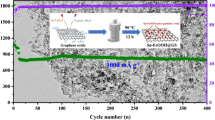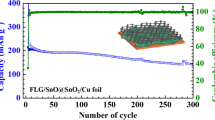Abstract
A dual functional CNTs@graphene/CNTs cathode for Li–Se battery was constructed by a CNTs@graphene network and a CNTs interlayer. CNTs were first integrated with graphene to form a three-dimensional (3D) framework and work together as a conductive matrix for Se confinement. The optimized composite cathode delivers a high initial capacity of 575 mAh·g−1 at 0.5 A·g−1 and good rate capacity with a retained capacity of 479 mAh·g−1 at 2.0 A·g−1 (73% of the capacity at 0.2 A·g−1). CNTs were further served as an interlayer to confine the diffusion of polyselenides by constructing a thin CNTs layer outside the CNTs@graphene network. An improved initial capacity of 616 mAh·g−1 at 0.5 A·g−1 is achieved with a retained capacity of 538 mAh·g−1 after 80 cycles, indicating the effective dual function of CNTs in this novel cathode construction and great application potential for Li–Se battery.









Similar content being viewed by others
References
Bruce PG, Freunberger SA, Hardwick LJ, Tarascon JM. Li–O2 and Li–S batteries with high energy storage. Nat Mater. 2011;11(1):19.
Black R, Adams B, Nazar LF. Non-aqueous and hybrid Li–O2 batteries. Adv Funct Mater. 2012;2(7):801.
Lim HD, Park KY, Song H, Jang EY, Gwon H, Kim J, Kim YH, Lima MD, Ovalle Robles R, Lepro X, Baughman RH, Kang K. Enhanced power and rechargeability of a Li–O2 battery based on a hierarchical-fibril CNT electrode. Adv Mater. 2013;25(9):1348.
Goodenough JB, Kim Y. Challenges for rechargeable batteries. J Power Sour. 2011;196(16):6688.
Li F, Zhang T, Zhou H. Challenges of non-aqueous Li–O2 batteries: electrolytes, catalysts, and anodes. Energy Environ Sci. 2013;6(4):1125.
Yang Y, Zheng G, Cui Y. Nanostructured sulfur cathodes. Chem Soc Rev. 2013;42(7):3018.
Zhang C, Lv W, Zhang WG, Zheng XY, Wu MB, Wei W, Tao Y, Li ZJ, Yang QH. Reduction of graphene oxide by hydrogen sulfide: a promising strategy for pollutant control and as an electrode for Li–S batteries. Adv Energy Mater. 2014;4(7):1301565.
Ji XL, Nazar LF. Advances in Li–S batteries. J Mater Chem. 2010;20(44):9821.
Ji XL, Evers S, Black R, Nazar LF. Stabilizing lithium–sulphur cathodes using polysulphide reservoirs. Nat Commun. 2011;2:325.
Abouimrane A, Dambournet D, Chapman KW, Chupas PJ, Weng W, Amine K. A new class of lithium and sodium rechargeable batteries based on selenium and selenium-sulfur as a positive electrode. J Am Chem Soc. 2012;134(10):4505.
Yang CP, Yin YX, Guo YG. Elemental selenium for electrochemical energy storage. J Phys Chem Lett. 2015;6(2):256.
Li J, Zhang C, Tao Y, Ling GW, Yang QH. The Li–Se battery and its C/Se composite electrode: opportunities and challenges. New Carbon Mater. 2016;31(5):459.
Cui Y, Abouimrane A, Lu J, Bolin T, Ren Y, Weng W, Sun C, Maroni VA, Heald SM, Amine K. Lithiation mechanism of Li/SeS(x) (x = 0–7) batteries determined by in situ synchrotron X-ray diffraction and X-ray absorption spectroscopy. J Am Chem Soc. 2013;135(21):8047.
Yang CP, Xin S, Yin YX, Ye H, Zhang J, Guo YG. An advanced selenium carbon cathode for rechargeable lithium–selenium batteries. Angew Chem Int Ed. 2013;52(32):8363.
Han K, Liu Z, Ye H, Dai F. Flexible self-standing graphene-Se@CNT composite film as a binder-free cathode for rechargeable Li–Se batteries. J Power Sour. 2014;263:85.
Ye H, Yin YX, Zhang SF, Guo YG. Advanced Se-C nanocomposites: a bifunctional electrode material for both Li–Se and Li–ion batteries. J Mater Chem A. 2014;2(33):13293–8.
Liu L, Hou Y, Wu X, Xiao S, Chang Z, Yang Y, Wu Y. Nanoporous selenium as a cathode material for rechargeable lithium–selenium batteries. Chem Commun. 2013;49(98):11515.
Liu L, Hou Y, Yang Y, Li M, Wang X, Wu Y. A Se/C composite as cathode material for rechargeable lithium batteries with good electrochemical performance. RSC Adv. 2014;4(18):9086.
Li Z, Yuan LX, Yil ZQ, Liu Y, Huang YH. Confined selenium within porous carbon nanospheres as cathode for advanced Li–Se batteries. Nano Energy. 2014;9:229.
Zhang ZA, Zhang ZY, Zhang K, Yang X, Li Q. Improvement of electrochemical performance of rechargeable lithium–selenium batteries by inserting a free-standing carbon interlayer. RSC Adv. 2014;4(30):15489.
Fang R, Zhou G, Pei S, Li F, Cheng HM. Localized polyselenides in a graphene-coated polymer separator for high rate and ultralong life lithium–selenium batteries. Chem Commun. 2015;51(17):3667.
Luo C, Xu Y, Zhu Y, Liu Y, Zheng S, Liu Y, Langrock A, Wang C. Selenium@mesoporous carbon composite with superior lithium and sodium storage capacity. ACS Nano. 2013;7(9):8003.
Han K, Liu Z, Shen J, Lin Y, Dai F, Ye H. A free-standing and ultralong-life lithium–selenium battery cathode enabled by 3D mesoporous carbon/graphene hierarchical architecture. Adv Funct Mater. 2015;25(3):455.
Jiang Y, Ma XJ, Feng JK, Xiong SL. Selenium in nitrogen-doped microporous carbon spheres for high-performance lithium–selenium batteries. J Mater Chem A. 2015;3(8):4539.
Hong YJ, Kang YC. Selenium-impregnated hollow carbon microspheres as efficient cathode materials for lithium–selenium batteries. Carbon. 2017;111:198.
Peng X, Wang L, Zhang X, Gao B, Fu J, Xiao S, Huo K, Chu PK. Reduced graphene oxide encapsulated selenium nanoparticles for high-power lithium–selenium battery cathode. J Power Sour. 2015;288:214.
Zeng L, Zeng W, Jiang Y, Wei X, Li W, Yang C, Zhu Y, Yu Y. A flexible porous carbon nanofibers-selenium cathode with superior electrochemical performance for both Li–Se and Na–Se batteries. Adv Energy Mater. 2015;5(4):1401377.
Li IL, Zhai JP, Launois P, Ruan SC, Tang ZK. Geometry, phase stability, and electronic properties of isolated selenium chains incorporated in a nanoporous matrix. J Am Chem Soc. 2005;127(46):16111.
Gates B, Yin Y, Xia Y. A solution-phase approach to the synthesis of uniform nanowires of crystalline selenium with lateral dimensions in the range of 10–30 nm. J Am Chem Soc. 2000;122(50):12582.
Wei W, Tao Y, Lv W, Su FY, Ke L, Li J, Wang DW, Li B, Kang F, Yang QH. Unusual high oxygen reduction performance in all-carbon electrocatalysts. Sci Rep. 2014;4:6289.
Acknowledgements
This study was financially supported by the National Basic Research Program of China (No. 2014CB932400) and the National Science Foundation of China (Nos. 21406161 and 51602220).
Author information
Authors and Affiliations
Corresponding author
Rights and permissions
About this article
Cite this article
Li, J., Zhang, C., Wu, CJ. et al. Improved performance of Li–Se battery based on a novel dual functional CNTs@graphene/CNTs cathode construction. Rare Met. 36, 425–433 (2017). https://doi.org/10.1007/s12598-017-0903-z
Received:
Revised:
Accepted:
Published:
Issue Date:
DOI: https://doi.org/10.1007/s12598-017-0903-z




